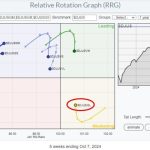The recent surge in the stock market has lifted many large-cap stocks to new all-time highs, but an interesting pattern has emerged as small-cap stocks seem to be lagging behind in this uptrend.
Small-cap stocks, which are characterized by companies with relatively small market capitalizations, have historically shown higher growth potential compared to their larger counterparts. However, the current market scenario presents a divergence from this trend as small-caps are not participating in the new all-time highs alongside the large-caps.
One possible explanation for this phenomenon could be the risk aversion among investors in uncertain times. The economic uncertainties brought about by the global pandemic, geopolitical tensions, and inflation concerns may be leading investors to favor the stability and perceived safety of large-cap stocks over the higher volatility associated with small-cap stocks.
Additionally, the performance of small-cap stocks is often closely tied to the overall health of the economy. With the recovery from the pandemic-induced downturn still ongoing, investors may be wary of the potential risks small-cap stocks face in a less predictable economic environment.
Another factor to consider is the influence of institutional investors. Large-cap stocks are typically more liquid and have higher trading volumes, making them attractive options for institutional investors with large capital pools. As a result, the buying power of these institutional investors may be disproportionately driving up the prices of large-cap stocks while leaving small-caps behind.
Furthermore, it is worth noting that small-cap stocks tend to be more sensitive to interest rate changes. With the Federal Reserve signaling a potential tightening of monetary policy in response to rising inflation, small-cap stocks could be facing headwinds as higher interest rates may increase borrowing costs and reduce profit margins for these companies.
In conclusion, the divergence between large-cap stocks reaching new all-time highs and small-cap stocks lagging behind raises questions about the underlying dynamics of the current market environment. Investors should carefully assess the factors influencing the performance of small-cap stocks and consider whether this trend is a temporary anomaly or a potential signal of broader market shifts. As always, diversification and a thorough understanding of the risks and opportunities in different market segments are crucial for building a resilient investment portfolio in any market conditions.



